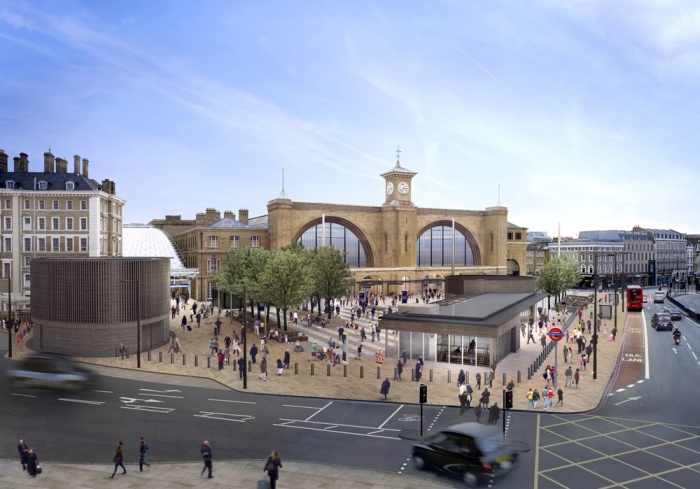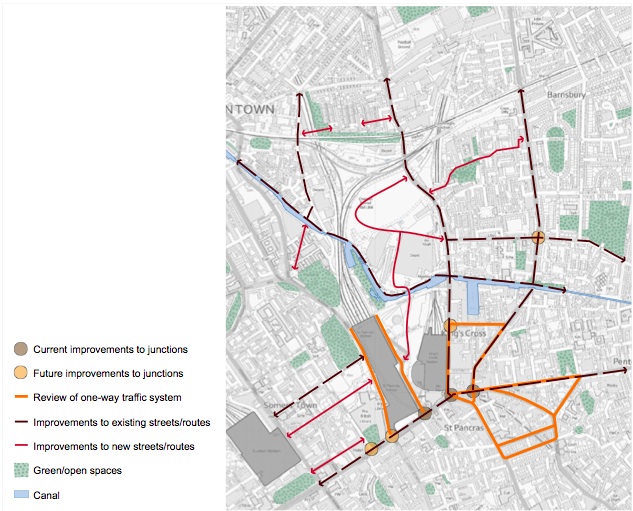Launch film: http://www.wilderfilms.co.uk/work/film/network-rail-kings-cross-station-launch-film/
Rail Lines
The King’s Cross-St Pancras (international station opened in 2007) area is a major transport hub for national and international rail, the underground and buses and is to an extent defined by the by major roads that pass through it. However, while it is one of the best connected areas in the country, movement within the area is often characterized by barriers that are difficult to cross for local residents, pedestrians and cyclists. This is a result of the one-way traffic system that dominates the area.
The opening of the Channel Tunnel Rail Link and the arrival of international services in the redeveloped St Pancras Station marked a significant step-change in the area. The subsequent opening of high speed services to Kent has further enhanced the breadth of transport links in the area including the ‘Javelin’ links to the in 2012.
King’s Cross and St Pancras stations are served by six underground lines where the capacity increases on underground lines serving the area now and ongoing; Thameslink cross- London services; mainline trains to the east midlands, north-east and Scotland; high speed services to Kent(opened in 2009); and Eurostar services to Paris and Brussels.
These services bring a high level of accessibility and large numbers of people to and through the area, but also bring congestion and give the area a transience which can impact negatively on local communities. Further international links are available including services to Frankfurt and Amsterdam. Euston Station, close by to the west, provides services to a wide range of further destinations and has also been identified as the London terminus for High Speed 2 .
Improvements to King’s Cross mainline station are underway which will significantly increase passenger capacity, with a new concourse and new platforms now open. A large new square will replace the ‘temporary’ concourse and canopy on Euston Road in 2013.
New public open spaces
Alongside transport investment, improvements are planned to a number of key public spaces and streets:
• King’s Cross Square: New square to the south of King’s Cross station on Euston Road to be completed in 2013;
• Station Square: A new square to be provided north of the western concourse of King’s Cross station completed in Summer 2012;
• King’s Cross Central: Extensive areas of new public open spaces including 20 new streets 10 new public spaces, including the ‘Boulevard’ leading from the stations to the new Granary Square between the canal and the new University of the Arts.
The number of visitors and people passing through the area means that many public spaces and footpaths are congested, particularly around the stations.
Local environment
The area is dominated by heavy traffic flow roads and major train lines, contributing to high noise levels and poor air quality. This leads to a poor environment for people visiting the area as well as the consequent health effects on the local population.
Making better use of the Regents Canal
The Regents Canal is an important asset but has not been used to its full potential in the past. Development at King’s Cross Central offers the opportunity to open up access and take advantages of the opportunities it offers as a corridor for recreation, movement and biodiversity.
However, in increasing use of the canal, it is important to balance needs of different users – walkers, cyclists, those using for recreation and those using it for commuting. There is also a balance to be struck between opening the canal up to wider use while maintaining its character as a series of tranquil spaces away from the hustle and bustle of King’s Cross.
Space around stations
The footways and public spaces around the stations are heavily used and often congested. Significant investment is planned in conjunction with station improvements including the major new square on Euston Road and the new public space north of the new western concourse.
The areas around the stations are the first impression that many visitors get of London and so they have an important role as a gateway, as well as for commuters and local people. These areas are the responsibility of a range of bodies including Network Rail, TfL, St Pancras International and Argent.
It is a high profile area which is important to Camden and to London as a whole. In particular the major transport hub at King’s Cross – St Pancras is of national and international importance and some of London’s best known institutions and attractions are on the area’s doorstep (e.g. the British Library, British Museum, UCL). However, what is less well known to visitors and those passing through the area is that the King’s Cross area is home to established resident communities – many with high levels of relative deprivation – and is also home to wide range of businesses including offices, creative industries and concentrations of more traditional industrial premises. The changes and investment occurring in the area present a range of opportunities to improve the lives of local people.
Sub-Area – The Station Hub
The area around the main stations is highly important to King’s Cross and Camden as a whole as a major transport hub and an arrival point where many visitors gain a first impression of the borough. This importance is heightened in the context of the 2012 Olympics and the role of the area as a gateway to the games, while there is also a need to maintain and improve accessibility for local people as the area develops. Key issues identified in this area include:
- Gateway to Olympics – The area is a ’gateway’ to the 2012 games with the high speed Javelin service from St Pancras to the Olympic Park at Stratford.
- Major roads and pedestrian crossings – Navigating the area can be difficult for pedestrians and road crossings are often convoluted and not very user friendly.
- General image/appearance – The general appearance of the area has improved significantly but issues remain such as some poor quality/boarded-up shopfronts and poor appearance of buildings like the Lighthouse.
- Visitor Information – The availability of information for visitors in the area is mixed, with mismatched signage inside and outside stations.



